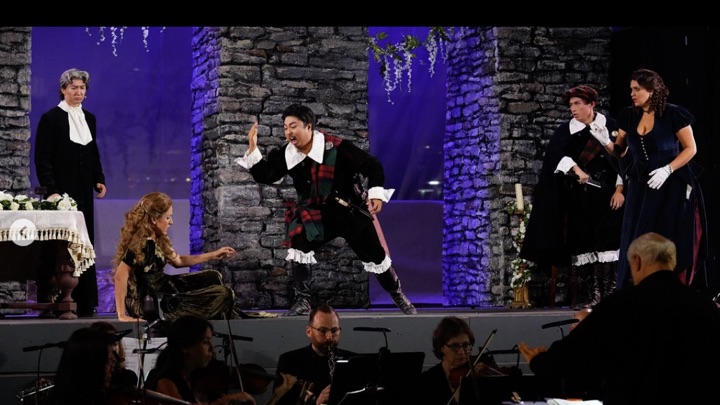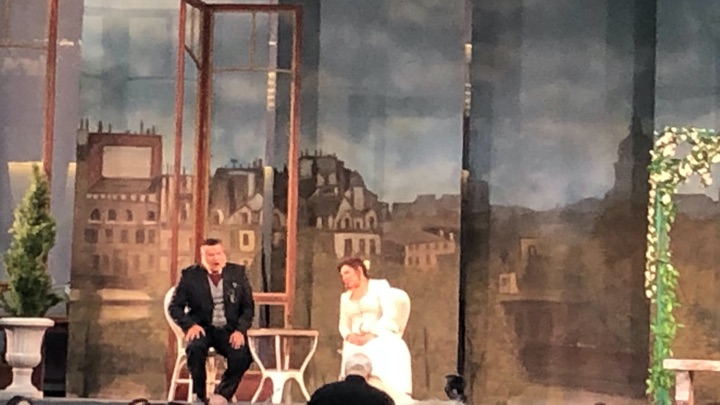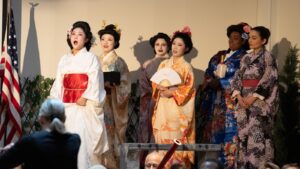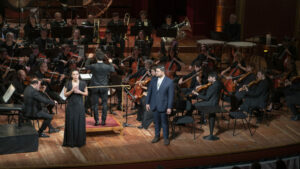
Announced productions like a staged production of Mascagni’s Isabeau and a Kurt Weill double bill last season quietly vanished from the schedule. This past season NYCO’s main offering was Ricky Ian Gordon and Michael Korie’s The Garden of the Finzi-Continis, a co-production with the National Yiddish Theatre Folksbiene.
For the past few summers (with the exception of 2020), City Opera has presented a series of outdoor concerts in Bryant Park as part of the Bryant Park Picnic Performances Summer Festival line-up sponsored by Bank of America. This summer featured The Barber of Seville, Pride in the Park (a June gay pride concert) and abridged staged versions of La Traviata and Lucia di Lammermoor with a reduced orchestra led by new music director Maestro Constantine Orbelian.
More and more, these concert events reflect the taste and leadership of the current General Director Michael Capasso. Capasso, the former general director of the defunct Dicapo Opera Theatre, features singers and repertory familiar from Dicapo with little or no resemblance to the original New York City Opera of Laszlo Halasz, Julius Rudel, Beverly Sills, Christopher Keene or Paul Kellogg.
Capasso now runs a company that lacks a resident orchestra and chorus with no theater to call home. City Opera depends on ad hoc funding due to a depleted endowment and no subscription base. Most of their productions are funded in collaboration with other arts presenters which provide financial sponsorship.
Generally their presentations have used familiar Dicapo stalwarts like Kristin Sampson and Peter Kendall Clark. However this summer featured some prominent international names and Metropolitan Opera stars like Charles Castronovo, Sarah Coburn, Ekaterina Siurina, Mark Delavan and Michael Chioldi.
I passed on The Barber of Seville May 27 opener due to the heat and overexposure to this particular opera buffa. The event was preserved on video for those who are interested.

However Capasso programmed a light crossover program which did feature gay or bisexual composers like the recently deceased Stephen Sondheim, Leonard Bernstein, William Finn, Jerry Herman, Ricky Ian Gordon, Kander & Ebb et al.
The evening began with a Tribute to Ukraine featuring Capasso’s Ukrainian emigrée wife Oleksandra Hrabova and daughter Daria Hrabova Capasso performing the Ukrainian National Anthem and a national folk song. Their performances were heartfelt rather than vocally authoritative.
The rest of the program featured musical theater showstoppers, a tribute to Stephen Sondheim and the La Guardia High School Show Choir performing choral highlights from Pippin, West Side Story and Lady Gaga’s “Born this Way”. The finale was the foolproof heart stirrer “Make Our Garden Grow” from Bernstein’s Candide featuring the full contingent of soloists and the student choir.
The whole affair had a catch as catch can quality with a mixed bag of soloists offering hit or miss solos dependent on the performers’ comfort with musical theater. An all-male quartet singing “I Feel Pretty” from West Side Story lacked the precise irony and style to make it either as a campy romp or legit musical theater. The A Little Night Music ensemble “A Weekend in the Country” fell apart due to poor coordination and a major memory lapse – signs of a lack of rehearsal and direction.
Talent was not absent onstage. Alto belter Lauren Hoffmeier nailed “Don’t Rain on My Parade” from Funny Girl (listen and take notes, Beanie!) and “I Wish I Could Forget You” a stalker’s lament from Fosca in Sondheim’s Passion. Baritone Peter Kendall Clark lavished sensitive phrasing and mellow expansive tone to “I Am What I Am” from Herman’s La Cage aux Folles.
Jordan Weatherston Pitts brought fresh vulnerability and deep commitment to “Being Alive” from Sondheim’s Company the baritenor tessitura sitting in the best part of his voice (listen and take notes, Katrina Lenk!). Tall, handsome basso Christopher Nazarian sang “The Impossible Dream” from Man of La Mancha with classic velvety legato and dignified assurance that raised the material above the overfamiliar tired schmaltz it has become.
Hunkentenor Glen Seven Allen brought stirring heroic conviction and sensitivity to “How Glory Goes” from Adam Guettel’s Floyd Collins but the melodic and musical construction are too diffuse for the song to score full impact. Barihunk Brian James Myer also gave his all to “Stupid, stupid man”, a ballad of homosexual repression and self-loathing from The Garden of the Finzi-Continis’ gay Alberto, but Ricky Ian Gordon’s music never lifted the emotion above the commonplace.
Light soprano Chelsea Bonagura and the versatile opera/musical comedy switch-hitter mezzo Melanie Long contributed bright moments throughout. The triumphant bravura performer in my book was Kathryn Olander, Music Director and pianist, who deftly navigated from the “Brindisi” from La Traviata to “Bosom Buddies” from Mame.
La Traviata on August 12 was altogether a more cohesive and well-integrated evening thanks to an alert and experienced maestro, Constantine Orbelian, leading a responsive orchestra, a workable traditional reduced staging and high level professionalism from a striking international trio of leading singers.
Leading the cast were the married opera couple Ekaterina Siurina and Charles Castronovo. Both have had somewhat patchy Met careers being seen either irregularly or not for many years. Castronovo should have been a Met homeboy starting out in 1999 as a member of the Young Artist Program debuting as Beppe in I Pagliacci the same night José Cura made his Met debut in Cavalleria Rusticana. Bits like the a Guard in Manon, the Sailor in Tristan and the First Prisoner in Fidelio followed.
Then Castronovo was gone for ten years, reemerging in 2012 as Don Ottavio and then disappeared for another two years coming back for one Bohème, in 2017 he was a Tamino. In 2018, he got a replacement gig in a revival of Roméo et Juliette vacated by either Stephen Costello or Bryan Hymel (or both). Last November, he returned to Bohème as Rodolfo and is due to return to the role in the upcoming season.
Meanwhile throughout Europe, Castronovo has sung leading roles at the Royal Opera House, Covent Garden, Vienna State Opera, Berlin State Opera, Paris Opera, Bavarian State Opera, Munich, Theatre Royale de la Monnaie, Brussels, and many others including at the Salzburg and Aix-en-Provence Festivals.
The Russian-born lyric coloratura Siurina made her professional debut in 1999, established herself in Europe and then debuted at the Met in 2006 as Gilda in Rigoletto. I saw her and it was a lovely performance in which her radiant silvery tone, delicate fioriture and limpid poise embodied the innocence, fragility and strength of the character. A Susanna in Nozze followed the next year and then silence…
Siurina went back to Europe as a regular in Vienna, Paris and London with side gigs in Berlin, Monte Carlo and Milan. Perhaps it was their choice to remain in Europe where they have been so beloved and can raise their children without being away from home too long.
Both singers are now in their late forties with Mr. Castronovo still very much in demand while Siurina is moving into roles like Rusalka and slowing down a bit. Perhaps their appearance in this abridged Traviata at Bryant Park and the Phoenicia International Festival of the Voice was an attempt to raise Siurina’s profile in the United States. Their voices have changed after two decades on the stage.
Castronovo still cuts a slim, dashing youthful stage figure yet his timbre has noticeably darkened and matured. The rather burnished, dark-grained but still lyric sound was perfect for middle Verdi and his background in classical bel canto provide a fine foundation for his well-shaped legato phrasing.
He also is a focused actor who balanced the boyish ardor of Alfredo with his hot-headed jealousy remaining sympathetic throughout. He seemed a preferable choice in the role compared to the bland callow Stephen Costello and other Met Alfredos of recent vintage.
Siurina began unsteadily as Violetta Valéry – her rather dignified matronly Act I courtesan moved cautiously through the coloratura lacking sensuality and sparkle. The very top notes seemed recalcitrant at times. “Ah, forse lui” revealed a darker shadow underneath the gleaming silver thread of tone suggesting melancholy and foreboding.
“Sempre Libera” was attacked without much abandon and Siurina dropped out of a few phrases in the last measures seemingly to prepare for a knock-your-socks-off high E-flat… which didn’t arrive.
Act II was more Siurina’s meat as Violetta becomes more broadly lyrical, serious and self-sacrificing. Here the cool purity of her tone seemed apt and her rendition of “Amami Alfredo!” was heart touching and radiant of timbre. Experience showed as Siurina squared off against the imposing Germont of Michael Chioldi culminating in “Dite alla giovane”. Siurina moved from strength to strength in the Gambling scene and the final act as Violetta becomes more desperate, fragile and eager for personal redemption. “Alfredo, Alfredo di questo core” and “Prendi, quest’é l’immagine” were deeply touching with arching beams of tone.
Act III did not show any kind of physical frailty but the voice did the work there. I think that Siurina could cultivate more of a floating pianissimo attack but the basic sympathetic beauty of the tone is unimpaired despite a top register no longer as responsive. However, as an actress Siurina could use her body more expressively and project more suffering instead of leaving it all to the voice.
Chioldi as Papa Germont was more dramatically convincing than he is as Rigoletto. The voice is a real Verdian instrument though he was in somewhat gruff voice with a hint of hectoring in his phrasing – again a little more light and shade and mezza voce would have made all the difference. It’s basically a very handsome instrument of major size and impact.
Smaller roles were taken by capable singers like Melanie Long and Christopher Nazarian who also provided backup in ensembles since there was no chorus. Cuts mainly impacted chorus passages and minor ensembles – Act III began with Alfredo’s entrance to Flora’s gambling party.
There was a unit set showing a cityscape of 19th century Paris with various arches (sometimes festooned with curtains, etc.) placed in front of it with tables, chairs and chaises suggesting interior spaces. Capasso’s stage direction was efficient and understated. Actor Bill Van Horn filled in the gaps in the story as the narrator framing the story as a flashback related to him by a grief-stricken Alfredo. His bits were blessedly brief and to the point.
Orbelian’s dozen or so players did justice to Verdi’s score on a more modest scale. It all came together nicely giving one a rather full impression of the opera in slightly more than two hours playing time including two intermissions.
The Lucia di Lammermoor on September 2 was more uneven with the abridgement, reduced orchestra, narration and semi-staging proving more problematic and the preparation and direction producing less cohesive results onstage.
The name stars were two shining lights in American opera during the aughts, here heard a decade or so after their glory years – coloratura soprano Sarah Coburn and dramatic baritone (now bass-baritone) Mark Delavan as Lucia and Enrico Ashton. There was a lot of fine singing to be heard but what surrounded it was more questionable.
The set was a series of gray stone pillars with a bunch of green mounds placed behind them – costumes were traditional 17th century, but ill-fitting with sometimes risible wigs and hats. There was no chorus and cuts abounded. Orbelian was less persuasive in Donizetti than in Verdi. Uniquely atmospheric solo instruments like the harp solo introducing Act I, scene 2 was jarringly replaced by a synthesized xylophone.
Thankfully the mad scene did have a flute available. But gaffes in coordination and ensemble emerged regularly. Large scenes that involved chorus and soloists were often a muddle – the direction and storytelling emerged more clearly with one or two protagonists onstage. Simon Stone’s trailer park Lucia at the Met may have been ugly but it always made sense maintaining a very clear, specific narrative.
Let’s get to the good stuff: Coburn, now in her mid-forties, remains a beautiful woman and a focused committed artist with a bright firm soprano. However, like Siurina, the very top of the voice is not as responsive as it was when she sang Donizetti’s French adaptation Lucie de Lammermoor at the Glimmerglass Festival to acclaim back in 2005. Her E-flats at the end of her Act I cabaletta “Quanto rapito in estasi” and in the Mad Scene were there but attacked bluntly in forte and not held long.
Her coloratura is still impressive but doesn’t float and sparkle like it used to – that fluid ease and radiance is no longer evident. However, everything she did told onstage – she played Lucia not as an overwhelmed girl child but as a defiant, tormented, trapped young woman capable of confrontation but also having this strength turn inward destructively.
Coburn worked off the text and projected dramatic intention in every phrase, cadenza or grace note. She is slim and acts with her entire body onstage projecting restless, youthful energy. When others got distracted, missed cues or lacked direction, Coburn kept her unerring course through the role. Again: Professionalism. Experience. Authority.
Delavan also showed a bit of age in the voice – the middle can be hollow and unsteady like late Cornell MacNeil in the late 70’s and 80’s. However, the top is a mighty roar and rock solid and he made a formidable antagonist full of vocal and dramatic energy. He warmed up as the evening went on and was always imposing.
Delavan again moved from strength to strength in Act II with both Coburn and Delavan working up major drama in “Soffriva nel Pianto” with the subsequent duet showing both at their current best. Both also have heavy American accents in their Italian which may contribute to a lack of liquid ease and tonal warmth. If Delavan no longer has a smooth legato and is a bit barkier in sound that is perhaps due to a shift into Wagner in the last decade – Delavan has a run of Wotans scheduled in a Ring cycle coming up later this season. Enrico Ashton would seem to be a relic from his past as a young baritone at NYCO in the 90’s.
Young Korean tenor WooYoung Yoon made a bright and persuasive first impression as Edgardo with bright tone and clear phrasing. But he seemed to get lost towards the second half of the Act I love duet, perhaps a missed cue from the conductor was to blame? However, his final double aria death scene revealed sunny bright tone, musical finish and vocal poise. The San Francisco trained Yoon has a good future in opera – he does not have a big voice but uses it in a most pleasing way going for tonal brilliance and elegant phrasing.
Everything surrounding the central trio resembled local amateur opera. Bass Tair Tazhigulov made some sonorous tones as Raimondo but looked clueless onstage. The rest of the comprimarios went from good (Elissa Pfaender as Alisa) to do not mention (I said do not mention!). Bill Van Horn’s angry Ashton retainer narrator was an intrusive and unconvincing interpolation.
Whatever the shortcomings (and I do not think this level of performance would play at Lincoln Center in competition with the Met) these were pleasing and heartening summer entertainments in a park filled with thousands of mostly young neophyte operagoers.
Many of these people I have never seen and never will see at the Metropolitan Opera or BAM. Not all stayed to the end, some were talking or using cell phones during the music. Noisy toddlers, motorcycle engines, overhead planes and car horns on 42nd Street pierced the balmy summer night with unwelcome cacophony.
But what we saw was real opera. Hopefully City Opera can retain some of this new young audience when they move their act indoors.
Photos: Eli Jacobson (Pride Concert, Traviata); Steven Pisano (Lucia)







Comments